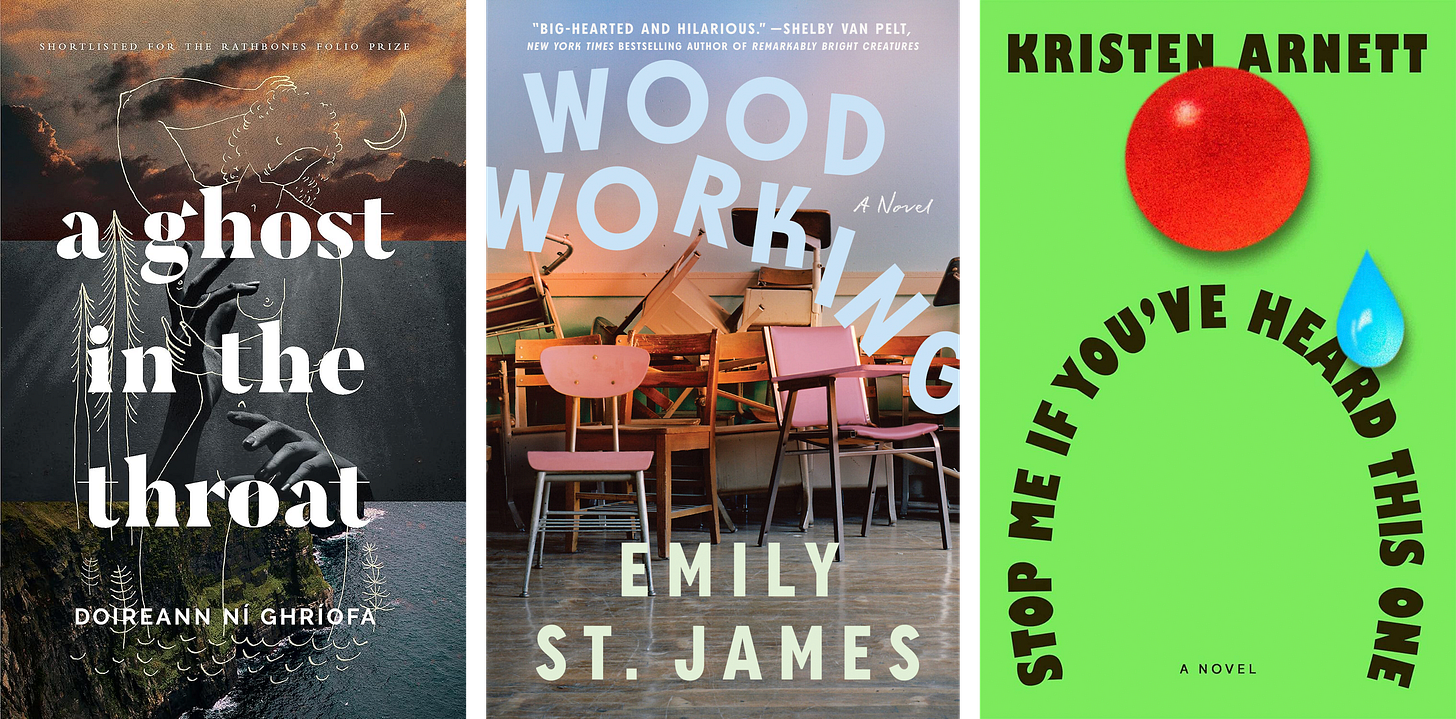Monday Miscellany: Conversation threatening to outlast the light
Notes from September 8 - 14
Another week? Another week! Physically I’m home, but spiritually I’m still here:
And yet, all vacations must come to an end, yes yes, I know. So I’m settling back into my own home and returning to the routines of Real Life™—which includes telling you about the books I’ve finished recently! Here they are:
Read this week
During the period of her life chronicled in A Ghost in the Throat, Doireann Ní Ghríofa is a busy mother, immersed in the whirlwind of nursing a new baby, caring for three other young children, and maintaining her household. I don’t have kids myself, but from the beginning I related strongly to her love of writing things down and crossing them off, which she describes beautifully.
I cling to my list because it is this list that holds my hand through my days, breaking the hours into a series of small, achievable tasks. By the end of a good list, when I am held again in my sleeping husband’s arms, this text has become a sequence of scribbles, an obliteration I observe in joy and satisfaction, because the gradual erasure of this handwritten document makes me feel as though I have achieved something of worth in my hours. The list is both my map and my compass. (7-8)
Amidst the chaos she finds herself seeking comfort in a famous Irish poem, “Caoineadh Airt Uí Laoghaire” (“Lament for Art O’Leary”), and as she returns to it again and again, she begins deeply researching the life of its author, a 17th-century noblewoman named Eibhlín Dubh Ní Chonaill. A Ghost in the Throat, then, becomes a great deal more than Ní Ghríofa’s own memoir—it is also biography of Ní Chonaill, history of her family, literary criticism of her work, discussion of the ways women are often erased from texts more broadly, and, at the end, Ní Ghríofa’s own translation of the poem that has captured her fascination for years.
This is a female text, which is also a caoineadh: a dirge and a drudge-song, an anthem of praise, a chant and a keen, a lament and an echo, a chorus and a hymn. Join in. (4)
I occasionally got a little lost down Ní Ghríofa’s rabbit holes, especially when she shifts from Ní Chonaill to her children and grandchildren; the details of these later generations’ marriages, offspring, occupations, and eventual deaths just didn’t hold my attention the way I could tell it held hers. Nonetheless, her writing style is poetic and lovely, and this book made an excellent companion as I sat in a rocking chair on the porch of our vacation cabin, listening to the birds and bugs and burbling creek.
Side note, I just found this video as I was looking up how to pronounce the author’s name, and can you even handle how sweet she is? I cannot! The accent!!
After emerging from this slow-moving, richly layered nonfiction, I was in the mood for a novel, so I picked up my library copy of Woodworking by Emily St. James. This is a 2025 release, one of the buzzy titles on my list to prioritize before the year is over. And it did not disappoint!
We follow Erica, a 35-year-old school high school teacher in South Dakota who has just gone through a divorce and realized she is trans. She develops an unlikely friendship with the only other trans person she knows, her student Abigail, and the two end up helping each other in ways neither of them could have predicted.
That’s all we are, maybe—people who pick each other out in a crowd and realize that the face of someone you’ve just met can feel like home. (343)
This is a big-hearted, deeply affirming story about self-discovery, transness, and life-saving community. It doesn’t shy away from the horrible and hurtful parts of being queer, but it’s also full of humor and beauty. Every moment I wasn’t actively reading, I was thinking about the characters and looking forward to picking up where I left off. If you need a dose of faith in humanity, definitely give Woodworking a try.
Finally, I started Stop Me if You’ve Heard This One by Kristen Arnett on Saturday night and finished it this morning with my coffee. This one also came from my “2025 releases to make it my beeswax to read before the year ends” list, but unlike Woodworking, it didn’t quite live up to my hopes. Which, to be fair, were high—I mean, “lesbian clown in Orlando trying to get her life together as she approaches thirty” is such a good setup!
I think the main thing that didn’t work for me was a lack of depth in the characters. The late-20s clown in question, Cherry, had a brother who passed away a few years back; he was one of the funniest people she’d ever met, and for some reason their mom always seemed to like him better. So Cherry is constantly imagining how her brother would react to her clowning routine and wishing that her mom would try to understand what’s she’s doing with her art. This comes up again and again throughout the book, but it’s all telling and not enough showing. We know Cherry misses Dwight. We know she wants to make his memory proud. We know she struggles in her relationship with her mom. But why? What happened in the past to cause this dynamic? What is making her dwell on it so intensely now? I kept feeling like some necessary pieces were missing, like I never fully connected with or understood Cherry as a person, and as a result the pacing seemed inconsistent and the big plot points toward the end lacked their intended emotional weight.
That said, I enjoyed the descriptions of Orlando (Arnett knows Florida, and it shows) and the discussions of creativity and performance. And I know that some friends whose taste I trust really liked this book, so take my minority opinion with a grain of salt if you’re considering reading it. I do recommend her earlier two novels, Mostly Dead Things and With Teeth, which feature a similar brand of dark Floridian humor that’s executed, in my humble opinion, a little more skillfully.
If you purchase a book through the bookshop.org affiliate links in this post, I may earn a small percentage commission. This is an easy way to support my work at no additional cost, and I appreciate it very much—thank you! ♥︎
Haiku round-up
Haiku is a poetic form that originated in Japan, containing seventeen syllables in a five-seven-five pattern. At the beginning of 2024, I started writing one every day, and while traditional examples include thematic reference to the seasons, mine tend to be a bit more all over the place. Here are this week’s efforts—enjoy!
Monday, September 8
Over roots and rocks, past lichen and mushrooms, up toward this blue expanse
Tuesday, September 9
Observe the machine parts well-oiled and functioning in miniature
Wednesday, September 10
We toast and we sip, the golden late afternoon electric with glee
Thursday, September 11
Watching and waiting, proving my trustworthiness At last, you appear
Friday, September 12
You’ve been daydreaming, but open your eyes and look: This could be a start
Saturday, September 13
One pint, two pints, three Conversation threatening to outlast the light
Sunday, September 14
No harvest too small to lovingly halve and share We relish this bite
Until next time
I haven’t been at the coffee shop in well over a week thanks to vacation, and with the idea of tomorrow’s opening shift (and 5am alarm) looming, the Sunday scaries are in full effect. I don’t WANNA. So I’m trying to balance those feelings out with thoughts of good things, like:
Starting a new book with breakfast1
Making myself an autumnal shift beverage and filming the latte art pour
Catching up with some favorite regulars
Returning to my quiet house after serving a ton of people in a loud environment all morning, and watching some Gilmore Girls while I savor something delicious for lunch all by myself
If you need this message too: we’re completely capable, and we’re gonna make it. I believe in us.
See you next Monday, and until then, some things are just more important than work.
♥︎ Emily
I didn’t mention this, but I’m planning to finally read the entire Twilight series since the first book will be celebrating its 20th anniversary next month!





